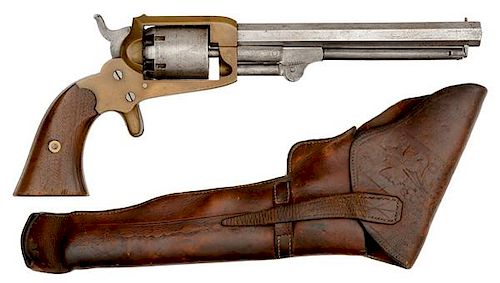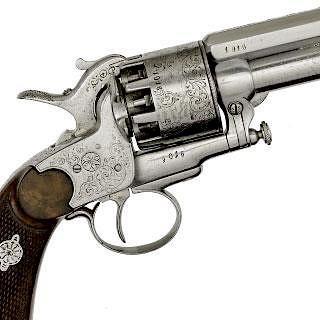Extremely Rare Confederate Cofer Third Type Revolver in its Original Holster Captured by 11th Maine Captain S.H. Merrill
About Seller
6270 Este Ave.
Cincinnati , OH 45232
United States
With offices in Cincinnati, Cleveland and Denver, Cowan’s holds over 40 auctions each year, with annual sales exceeding $16M. We reach buyers around the globe, and take pride in our reputation for integrity, customer service and great results. A full-service house, Cowan’s Auctions specializes in Am...Read more
Two ways to bid:
- Leave a max absentee bid and the platform will bid on your behalf up to your maximum bid during the live auction.
- Bid live during the auction and your bids will be submitted real-time to the auctioneer.
Bid Increments
| Price | Bid Increment |
|---|---|
| $0 | $25 |
| $500 | $50 |
| $1,000 | $100 |
| $2,000 | $250 |
| $5,000 | $500 |
| $10,000 | $1,000 |
| $20,000 | $2,500 |
| $50,000 | $5,000 |
| $100,000 | $10,000 |
About Auction
Apr 26, 2016 - Apr 28, 2016
Cowan's Auctions dawnie@cowans.com
- Lot Description
.36 caliber, 7.375" octagonal barrel, S/N cryptic letter L. Top of frame marked T.W. Cofer Patent. Barrel marked Portsmouth Va. Brass frame, walnut grips, iron barrel and cylinder. Top of frame is notched for sighting. Removable left brass sideplate unlike any other Confederate handgun produced.
Included with the revolver is a leather holster that has been with this Cofer since it was captured. Written in ink on the reverse side of the holster by the belt loop: 21 July 1864. This Revolver and holster was captured from a Rebel Signal Officer, Capt S. H. Merrill 11th Maine Regiment.
Simeon H. Merrill was a 20-year resident of Bridgeton, Maine when the Civil War broke out. Answering a 90-day call for service, he enlisted as a Corporal in Co. C of the 1st Maine Infantry on May 3, 1861, and served until August. He re-enlisted on November 7, 1861, this time as a Second Lieutenant in Co. I, of the 11th Maine Infantry. He was promoted to Captain in January, 1862, and, after the loss of two superior officers, took command of the entire regiment from August 16th to November 2, 1864. According to the unit history, Merrill "...was known to the regiment as an officer of tried mettle, with fighting experience dating to the Battle of Fair Oaks, where he had commanded most of the companies on the skirmish line and had earned high commendation for the skill and courage he had shown" When his superiors fell, "...the men of the regiment now looked to him with confidence and obeyed his clear voiced orders without question in the exciting events that followed." (Hill, 1896: 248). Not long after assuming command of the regiment, his three-year term of service elapsed, and Merrill mustered out of service.
The 11th Maine served in the eastern theater, and during Merrill’s period of enlistment was actively involved in numerous engagements including the Peninsula Campaign, the Siege of Yorktown, the Battle of Seven Pines, Bermuda Five Hundred, Siege of Charleston, and the Sieges Petersburg and Richmond in 1864.
Based on the date inscribed on the holster -- July 21, 1864 -- Merrill and the 11th were attached to the Army of the James in the run-up to the battle of Deep Bottom, Virginia on July 27th-29th. While the exact circumstances surrounding the capture of the Cofer and holster offered here are lost to time, the unit history of the 11th provides a general description of the engagement.
On June 21st, the 11th crossed over Strawberry Plains, Virginia in order to reconnoiter the Confederate front. They were soon engaged by a Confederate battery that had been shelling their camp on the 20th. Eleven prisoners were captured before the Confederates regrouped and the 11th was forced to retreat. Presumably, the Cofer was captured during this action, and it makes sense that a Signal Officer might have been attached to the battery. Sadly, the unit history makes no mention of the names of the prisoners, or any war prizes.
One of the few Confederate handguns that were produced under contract and actually delivered and issued to Confederate troops, the Cofer has always been known as the “Walker” of Confederate revolvers. There are a total of fifteen Cofer revolvers known to have survived, with at least three variations - the first type with a bored-through cylinder which fired a cartridge with recessed percussion nipple; the second type with a cartridge with the percussion nipple on the back of the cartridge; and the third type with a percussion cylinder.
This Cofer is the best documented of any in existence, both in terms of its war-time use, as well as its extensive provenance. A cornerstone for any advanced Confederate arms collection, and not on the market for more than 60 years.
Provenance:
Lawrence Kinney, Farmington, Maine
Lawrence Kinney to Robert Ebber, Freeport, Maine, for $20
Robert Ebber to Dewey Bryan, Grey Maine for $135
Robert Ebber (broker) for Harold Cox, Natick, Massachusetts, to Cliff Young, Boston, Massachusetts, $395 in 1953.
(Auctioneer's Note: Included with this lot is an extensive archive detailing its complete history of ownership. Among the gem's: Cliff Young's canceled 1953 check for $395 for the purchase of the revolver.
Literature:
Albaugh, William. Confederate Handguns. Riling, 1963: page 149, exact gun illustrated.
Hartzler, Daniel, Whisker, James, & Yantz, Larry. Arming the Glorious Cause, a Study of Confederate Arms. Bedford: self-published, 1998: page 96, exact gun and holster illustrated.
Gary, Bill. Confederate Revolvers. K8 Communications, 1987: pages 148-151, exact gun illustrated.
Hill,J.H. The Story of One Regiment: The Eleventh Maine Infantry in the War of Rebellion, Press of J.J. Little and Co., 1896.
M. Clifford Young. "The Legacy of a Tidewater Gunsmith-- Thomas W. Cofer." The American Society Of Arms Collectors Bulletin No Seventy Two.
All lines are very sharp and crisp. Markings are clear and sharp. All metal parts have a nice light untouched patina. Brass is untouched with nice dark mustard look. Grips are excellent with nice feathered grain look. Bore is excellent with sharp rifling. Holster is in outstanding condition. This is the only known Cofer revolver still in the original holster with captured markings in outstanding condition.Condition
- Shipping Info
-
SHIPPING. At the request of the buyer, Cowan's will authorize the shipment of purchased items. Shipments usually occur within two weeks after payment has been received. Shipment is generally made via UPS Ground service. Unless buyer gives special instructions, the shipping method shall be at the sole discretion of Cowan's Auctions, Inc.. Cowan's is in no way responsible for the acts or omissions of independent handlers, packers or shippers of purchased items or for any loss, damage or delay from the packing or shipping of any property.
-
- Buyer's Premium



 EUR
EUR CAD
CAD AUD
AUD GBP
GBP MXN
MXN HKD
HKD CNY
CNY MYR
MYR SEK
SEK SGD
SGD CHF
CHF THB
THB


















